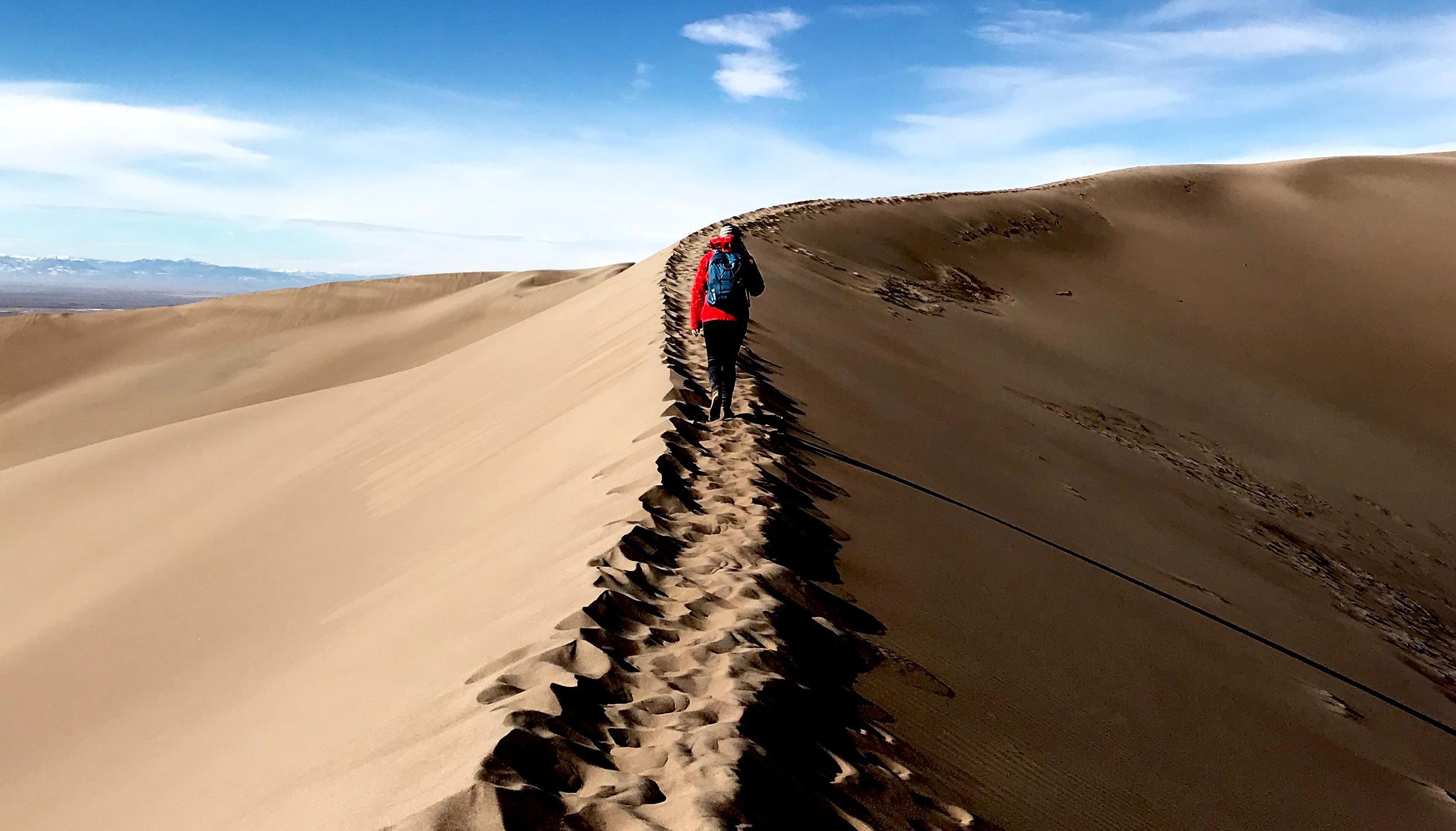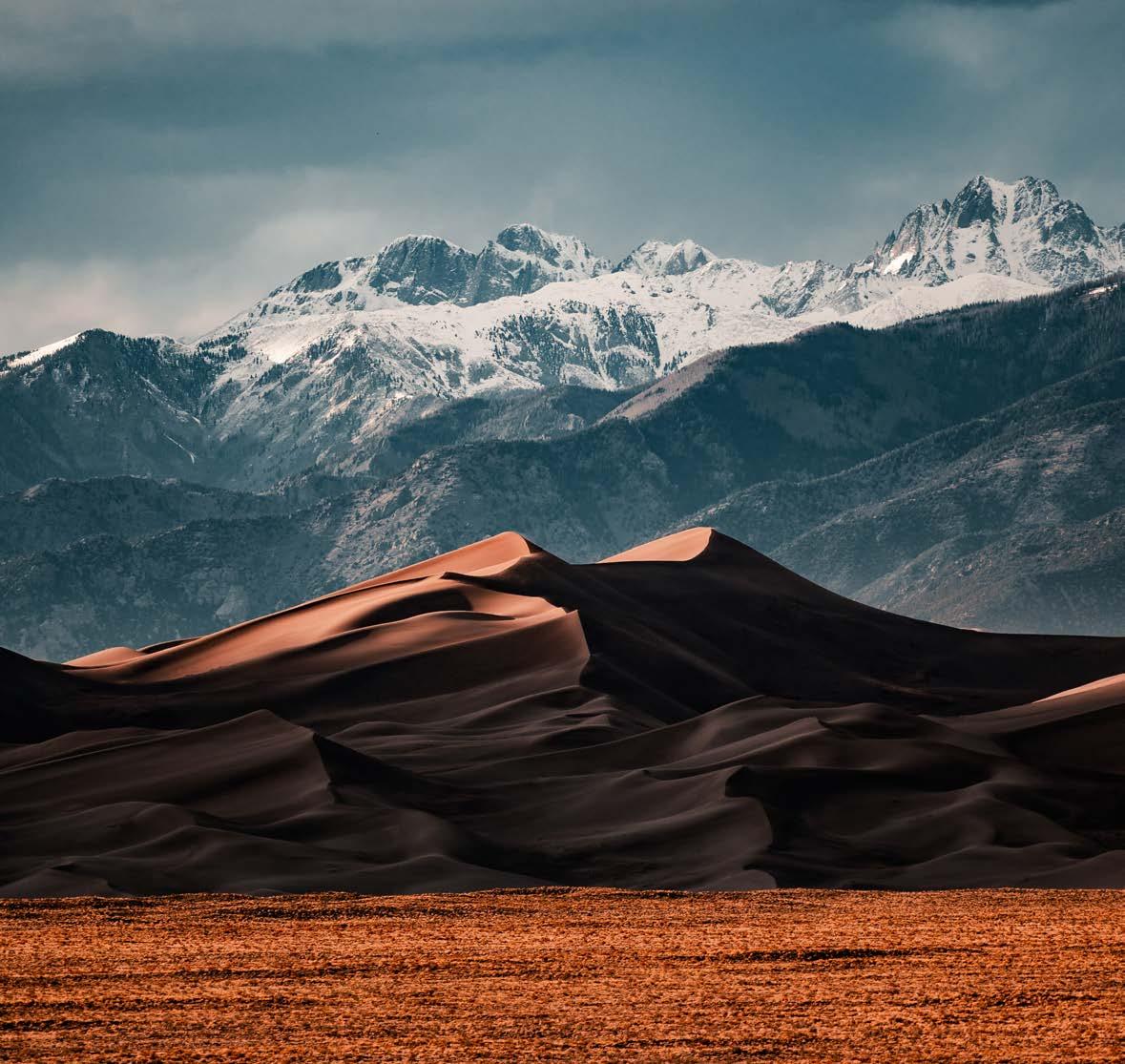
3 minute read
Great Sand Dunes National Park and Preserve
The hunting and gathering grounds for several Native American tribes — including the Ute and the Jicarilla Apache — human history at Great Sand Dunes
National Park and Preserve can be traced back 11,000-plus years. Having attracted explorers and goldminers, along with ranchers, farmers and homesteaders, it’s a land where sacred spots hold spiritual meaning to this day.
Located in southern Colorado, it encompasses towering sand dunes — the tallest in North America — offset by the seasonal
Medano Creek beach at their base; backcountry canyons, where a primitive road snakes toward the Sangre de Cristo mountains; and trails that traverse forests, grasslands, wetlands and alpine lakes, like trout-populated Medano Lake, with its tundra wildlife.
It all adds up to a confounding landscape that sparks wonderment.
An International Dark Sky Park, Great Sand Dunes is a best kept secret where you can summit a 13,000-foot mountain peak, watch pronghorns graze and plunge into frigid waters in one fell swoop.
Flora And Fauna
It feels as though there’s no end to the geological and climatic variation at this unique national park. Among its wildly varying environments you’ll find:
Alpine tundra as high as 13,604 feet
Subalpine forest with crooked trees
Lakes and tarns that provide a habitat for trout and highaltitude amphibians
Subalpine meadows filled with Rocky Mountain species Montane forests and woodlands swathed in pinyon-juniper and ponderosa pine
A riparian ecosystem intersected by creeks
A vast dunefield of shifting sands, surrounded by grasslands and shrublands
Sabka wetlands punctuated by inland saltgrass
Wetlands that provide a haven for saltwater shrimp
From elk to bears, raptors, mountain lions, grouses, turkeys and mule deer, there is wildlife aplenty, just waiting to be observed.
The Weather
The National Weather Service identifies three main locations within the park: Visitor Center/Campground/ Dunefield at an elevation of 8,200 feet; Medano Pass, at an elevation of 10,000 feet; and Sand Creek Lakes, situated 11,745 feet above sea level.
Spring can bring high winds, along with highs that may reach into the 60 F range — or only into the 30 F range, though it may feel colder due to windchills. March and April are the snowiest months of the year. When summer arrives, daytime high temperatures average 75 F to 80 F, but sunbaked sand surface temperatures can soar to 150 F.
Fall is comfortable, with temperatures around 60 F to 70 F. With the risk of snow and icy rain, winters prove quite cold, with average highs in the teens to 30 F range, and lows averaging between -15 F to -5 F.
THE HIKES, DRIVES AND VIEWPOINTS
HIGH DUNE & STAR DUNE
Whether you simply sink-hike your way through the dunes or sand sled or sandboard down them (a blast!),
ABOUT THE PARK LOCATION
Southern Colorado, in Alamosa and Saguache counties
ESTABLISHED
March 17, 1932
AREA
107,342 acres, plus an additional 41,686 acres of preserve trekking the ambiguous, 3-mile, outand-back trail is fun and forever in flux since wind-blow shapes and shifts the landscape. It’s also deceptively challenging given its all-sand climb.
Look for the route to High Dune behind the visitor’s center at the Dunefield parking lot, choosing the ridgeline you’d like to follow, based on the steepness you can tolerate.
Advanced hikers should combine an ascension to Star Dune, which gains 1,309 feet in elevation as you journey from the base of the dunes to the summit.

Medano Creek Trail
An easy, point-to-point hike, the unofficial Medano Creek Trail is a seasonal one that occurs when the creek bed surges with snowmelt in spring, gradually disappearing in the heat of late summer and early fall. Walk through the park along the creek when you can, appreciating a unique phenomenon — a “surge flow,” which occurs when underwater sand bridges build up and then break every 20 or so minutes, sending a wave down the creek that’s perfect for skimboarding or belly-surfing.
Mosca Pass Trail
Climbing 1,463 feet into the mountains, the strenuous, 7-mile, wildlifepopulated Mosca Pass Trail intersects gorgeous forests of pinyon, juniper, spruce, aspen and fir before cutting through grasslands as you reach the top of the pass.
Montville Nature Trail
Looking for a hike on solid terrain? The easy, .5-mile Montville Nature Trail is for you. It travels along solid terrain on a forested walk along a creek before passing through a small, old settlement.











